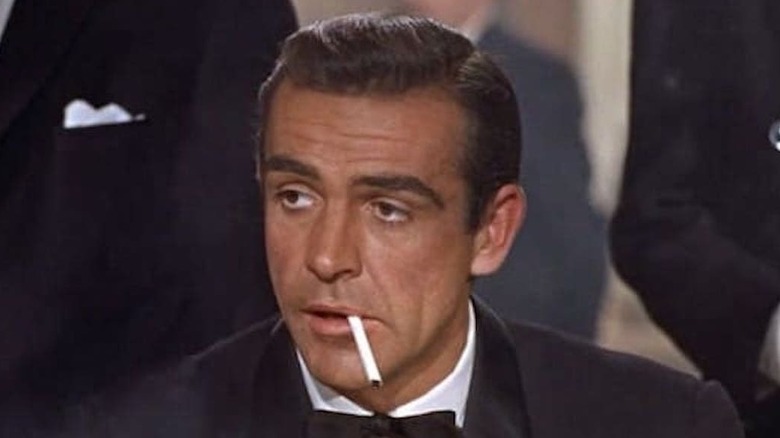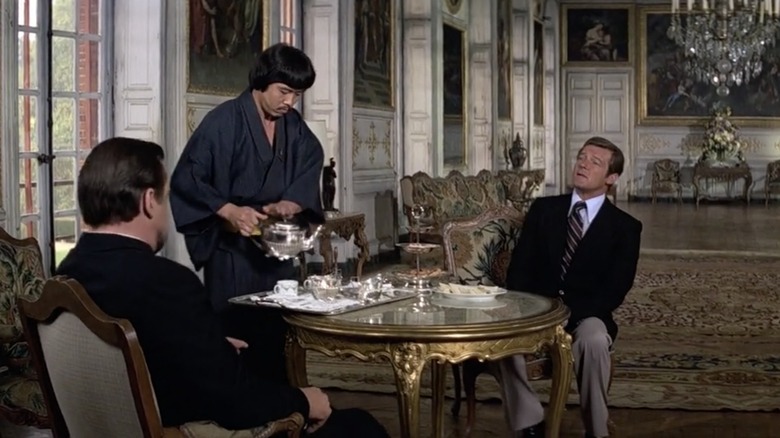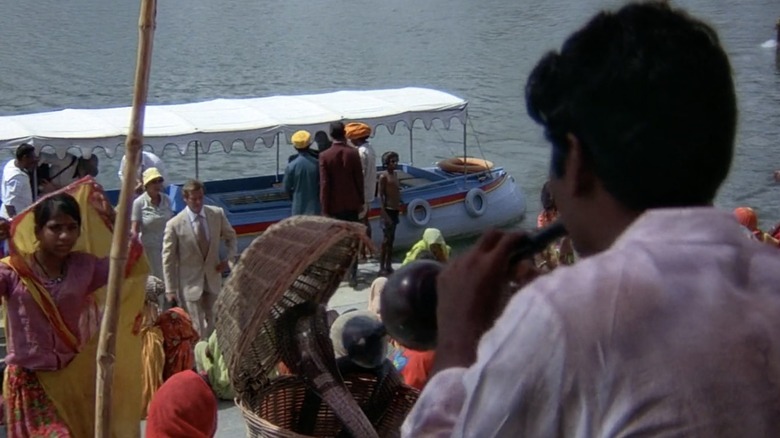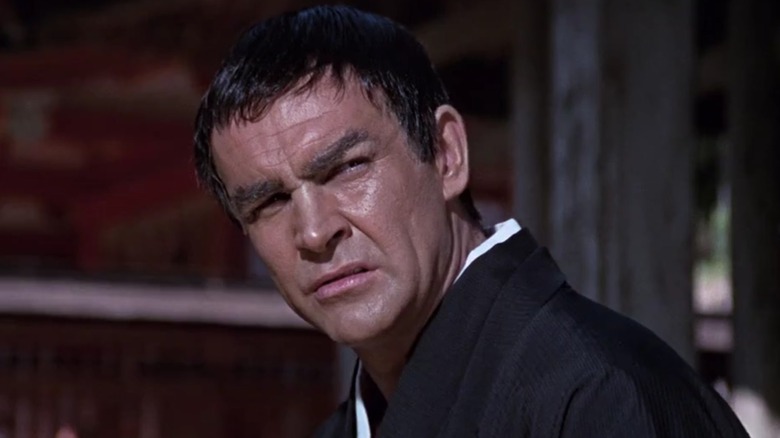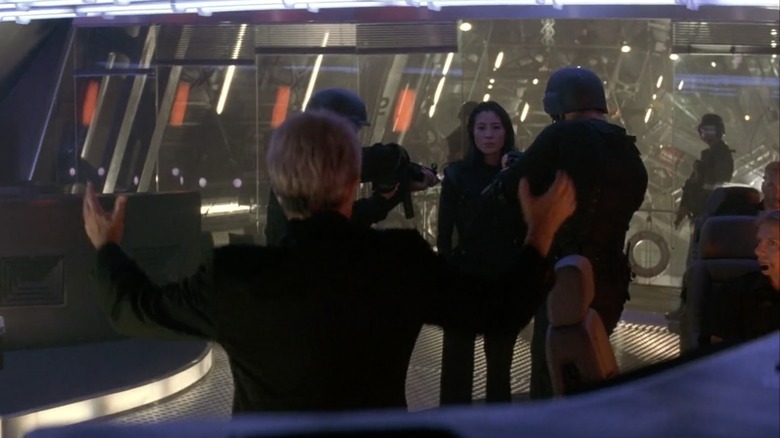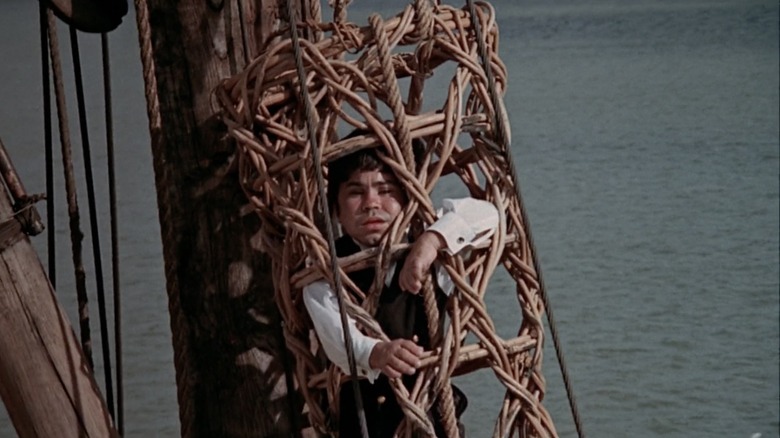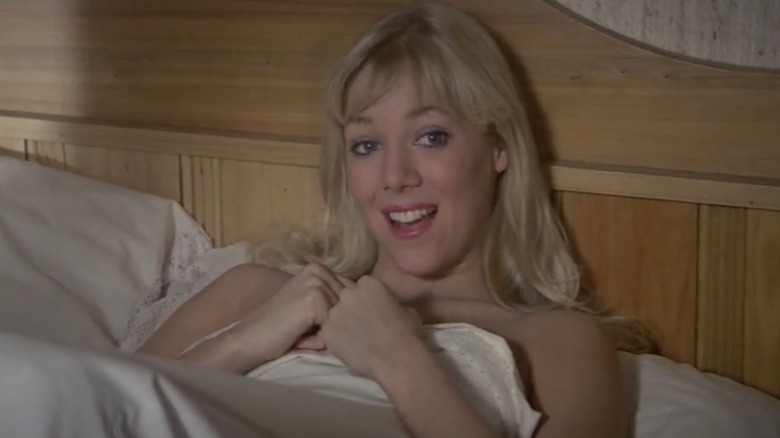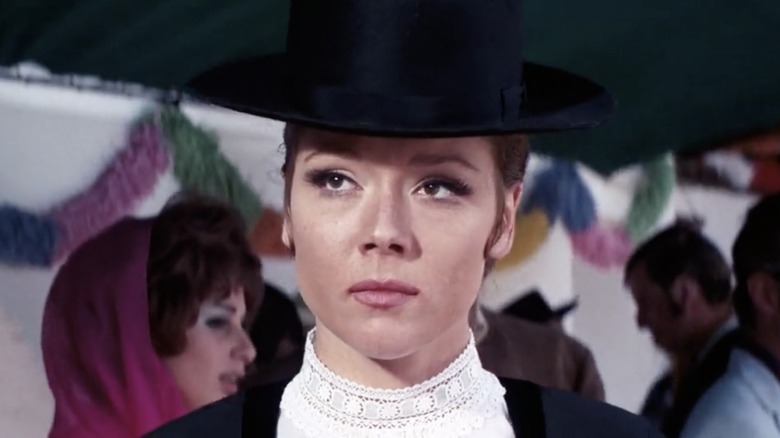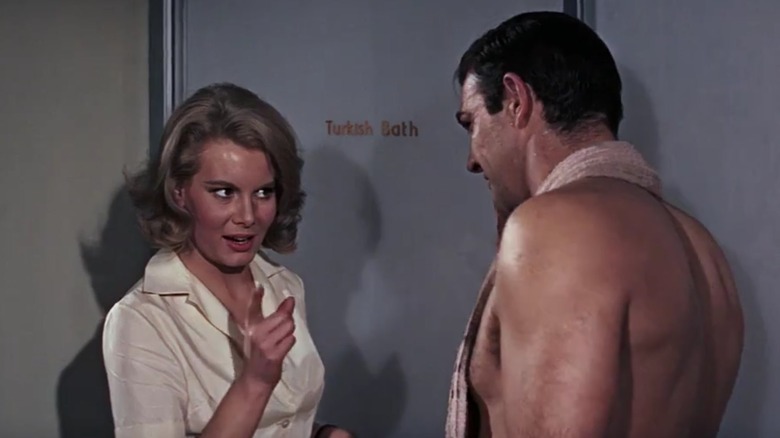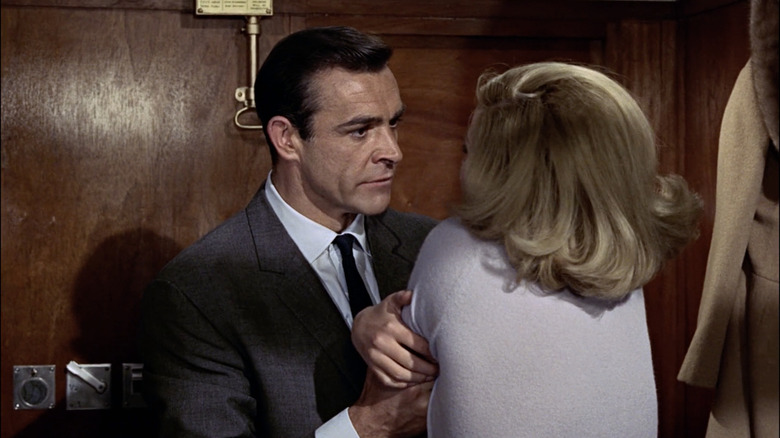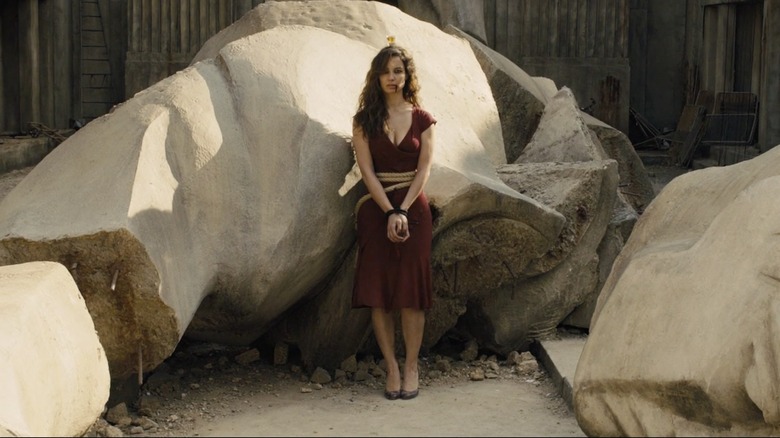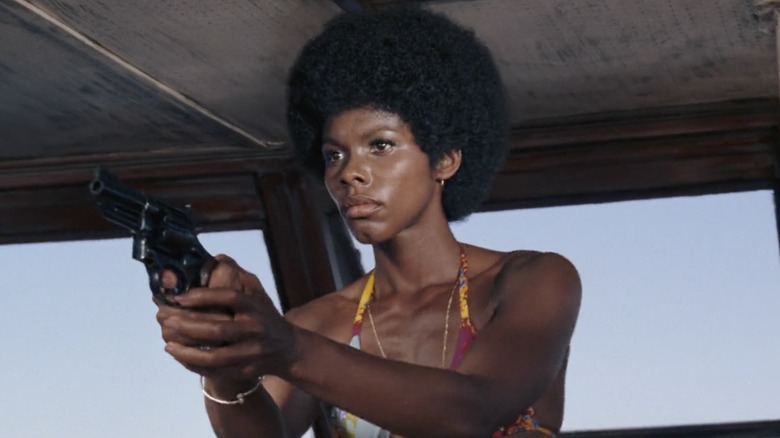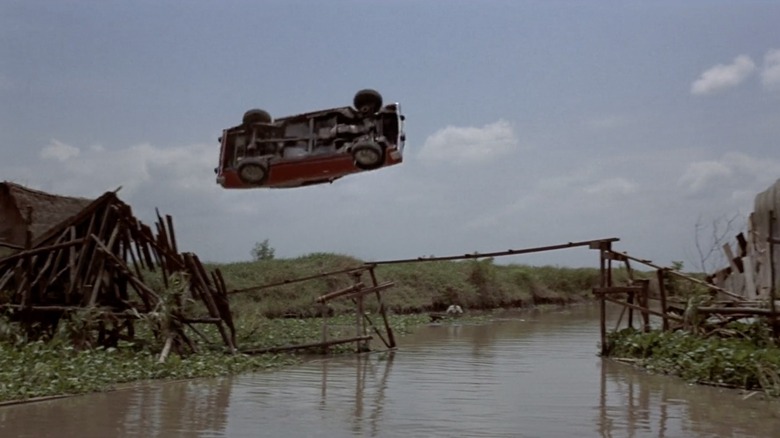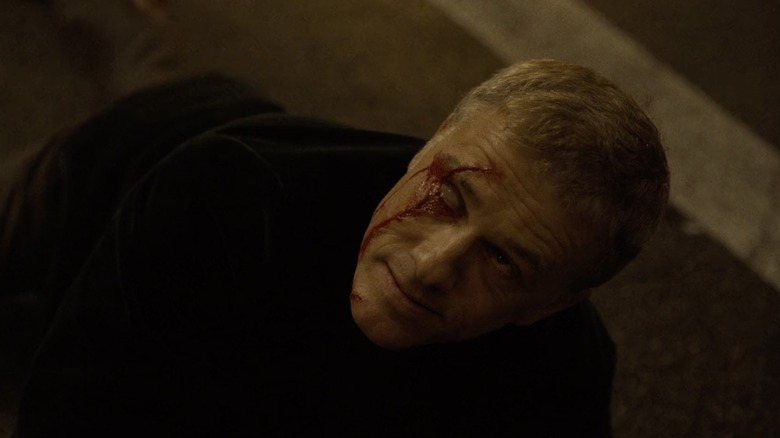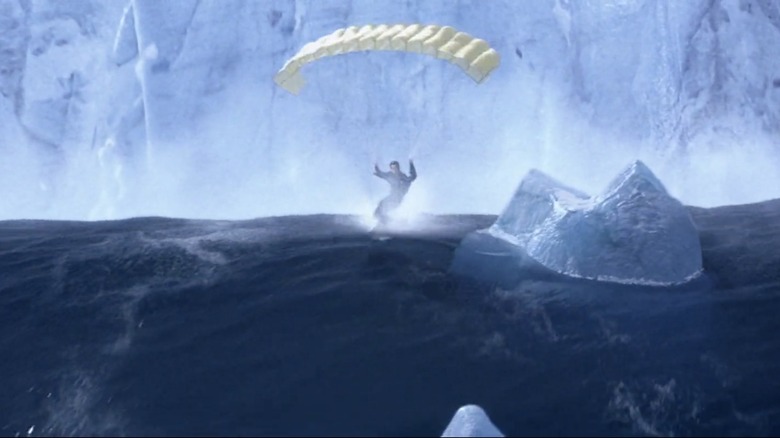Questionable Things We Ignore In James Bond Films
Since their cinematic debut in 1962, the James Bond films have enjoyed nearly six decades on the big screen, easily making the franchise one of the longest continuous runs in cinema history. Any film series with such longevity is bound to run into an eyebrow-raising wrinkle or two. Sure enough, the Bond films have several uncomfortable elements that range from the embarrassingly goofy and the poorly aged to the genuinely disturbing. For die-hard fans and those with a nostalgic connection to the older renditions of 007, these can be difficult truths to reckon with, either shoved under the bed and ignored completely or rationalized away as "the product of another time."
In the interest of confronting some of the franchise's uglier parts head on, here are some of the more questionable things in the Bond franchise that most fans would prefer to forget.
Fair warning: spoilers ahead for much of the James Bond franchise. The following article includes descriptions of fictional physical and sexual assault.
The casually racist quips
The Bond films have been around for almost six decades. In that time, cultural standards about what is and isn't hurtful to joke about have changed considerably. If you watch older films, you will invariably encounter a fair amount of casual racism, often disguised as cheeky quips.
Take "Octopussy," for example, which predominantly takes place in contemporary India. In one scene, when Bond hands his casino winnings to an Indian character, he says, "That'll keep you in curry for a few weeks." Likewise, in "Moonraker," Bond throws a henchman of Asian descent out of a bell tower onto a piano, before coolly remarking: "Play it again, San." Prejudice in jest is still prejudice.
There's also the character of Sheriff J.W. Pepper (Clifton James), who twice played a low-level Bond antagonist. Although the movies definitely intend to mock Pepper's backwater ignorance and provincialism, it's still uncomfortable to see his racism used as comic relief.
The constant national stereotyping
Aside from the jokes, there's the more fundamental way in which Bond doesn't pass present-day woke tests: Working for Her Majesty in postcolonial settings like Hong Kong and Jamaica, Bond represents imperialist power.
Bond's jingoism aside (and that's a big aside), jet-setting comes with the espionage territory, so it makes sense that Bond's high-stakes adventures take him on a world tour of sorts. However, sometimes these journeys delve into travelogue territory. The travelogue genre constitutes a very subjective kind of tourism: a first-hand account of one's travels in a foreign country. While not necessarily dodgy, there is a tendency for travelogues to reproduce and reinforce national and racial stereotypes. They are an account of one nationality created by and for another nationality. What could go wrong?
The Bond films, especially the early ones, have this less-than-savory travelogue vibe. As Paper's Sandra Song notes, it's an attitude rooted in author Ian Fleming's original prose, which relied heavily on "one-dimensional stereotypes" of other races and even the occasional outright claim of whites' racial superiority. Eep. Whether you consider this a matter-of-fact portrayal of regrettably common attitudes at the time or a Fleming-endorsed view, there's no question that it's problematic.
You get a glimpse of this in 1983's "Octopussy," which features, as Den of Geek astutely puts it, "a Racist's Guide to India." Around every corner are men lying on beds of nails, fire-eaters, snake charmers, and sword swallowers. There's no other way to describe it than "what a white person in 1983 probably thought everyday India looked like." Although Bond is supposed to be worldly and cosmopolitan, the cartoonish, over-the-top portrayal turns India into an offensively cliché-riddled amusement park.
Remember that time Bond pretended to be Japanese?
Sure, 007 is a spy, but he rarely goes undercover. Heck, the guy's go-to move is introducing himself, full name and all, to any pretty young thing who happens to ask. One of the most famous lines in the series is "The name's Bond. James Bond." He basically enters every room with: "Hi! I'm a spy."
The few times Bond has gone undercover, he's been, uh, less than successful. Remember in "On Her Majesty's Secret Service," when he pretends to be a genealogist and immediately blows his cover? Disguises are not this man's strong suit.
The most egregious example of why Bond should never go undercover takes place in 1967's "You Only Live Twice," Sean Connery's penultimate outing and arguably one of the most poorly aged entries in the whole franchise. In the film, the villainous organization SPECTRE is up to its old tricks: sowing seeds of discontent between the U.S. and the U.S.S.R. by stealing nukes. In his attempt to foil their plan, Bond travels to Japan, where — with the help of the head of the Japanese secret service, Tiger Tanaka (Tetsurō Tamba) — Bond goes undercover as a Japanese fisherman with a spray tan, a wig, and prosthetic eye flaps. Yikes.
Yellowface has been a part of the Bond film's legacy since its cinematic debut, "Dr. No" (both Joseph Wiseman and Zena Marshall, who portray Chinese characters, are white). While every Bond fan revisiting the films from the 1960s knows to steel themselves for some challenging moments, nothing can really prepare you for seeing Sean Connery made up to look like a Japanese person.
Elliott Carver's embarrassing "kung fu"
"Tomorrow Never Dies" sees 007 (Pierce Brosnan) face off against Elliot Carver (Jonathan Pryce), a corrupt media mogul who plans to incite a war between the U.K. and China to obtain exclusive Chinese broadcasting rights for the next 100 years. In the third act, Bond and his ally Wai Lin (Michelle Yeoh), a Chinese Ministry of State Security agent, covertly board Carver's ship in the South China Sea to prevent the madman from firing a stolen missile at Beijing. Maybe they could have been a little more covert, because Wai Lin is captured immediately during the attempt. And it's at this point, dear reader, that Carver does something absolutely ridiculous.
While Carver gloats over Bond's (presumed) death, the restrained Wai Lin admirably takes advantage of the monologuing villain and kicks furiously in his direction. Visibly shaken, Carver collects himself in the silliest (and indeed, most racist) way possible, imitating stereotypical kung-fu moves and vocalizations for way, way too long. Whether Carver is mocking Wai Lin (and kung-fu more broadly) or genuinely attempting to frighten her with his own "skills" is a bit of a mystery. Whether the audience is meant to grimace or laugh at this display is also unclear. Either way, Carver's childish mimicry is more than a bit cringe-inducing. It also strikes a weird tone in what's supposed to be a dramatic, high-stakes finale.
The disrespectful treatment of Nick Nack
1974's "The Man with the Golden Gun" sees Bond (Roger Moore) hot on the heels of famed triple-nippled assassin Francisco Scaramanga (Christopher Lee). Scaramanga is an eccentric crack-shot with a trusty servant named Nick Nack (Hervé Villechaize), a man with dwarfism. Like any good henchman, Nick Nack does his best to kill Bond when he can.
During a scuffle on a boat at the end of the film, Bond stuffs Nick Nack in a suitcase. The encounter is played for laughs at the expense of Nick Nack's size. Sure, Bond has a right to defend himself against would-be murderers, but his treatment of Nick Nack as a mere object is undignified and dehumanizing.
When Bond returns to woo Bond girl Mary Goodnight, he implies that he tossed the suitcase overboard and on that grim note, they resume making love. Sexy! It's later revealed that Bond didn't chuck Nick Nack overboard, but rather opted for further humiliation by shutting him in a lobster trap and suspending him off the ship's mast. Nick Nack himself says it best: Bond is being a bully here.
Bibi Dahl being uncomfortably young
Portrayed by American ice skater and actress Lynn-Holly Johnson, wide-eyed Olympic-hopeful Bibi Dahl appears in James Bond's 1981 outing "For Your Eyes Only." Bibi is a financial cover by Aris Kristatos, a smuggler using his sponsorship as a front for his life of crime. When Bond and Bibi first meet, she is immediately taken with the enigmatic spy. Bibi's advances make Bond and the audience uncomfortable because she's way, way younger than him. Bibi is meant to be just 16 years old, while Bond is middle-aged (Bond seems unaffected by the passage of time, portrayed as being perpetually in his mid-30s). In reality, at the time of the film's release, Johnson was 23 and Sir Roger Moore was 54 — quite the age gap. Carole Bouquet's Melina, Bond's other love interest in the film, was only a year older than Johnson.
It's difficult to watch Bibi (who, again, is supposed to be 16) keep throwing herself at the much older and visibly uncomfortable Bond. From unrequited flirting and appearing naked in Bond's bed to kissing him without consent, there's a lot of squirm-inducing stuff going on here. Her name being super infantilizing doesn't help. We're just relieved that Bond wasn't into it.
Bond being with Tracy because he needed her father's help
It is a tragedy that "On Her Majesty's Secret Service" is the sole outing of one-and-done Bond actor George Lazenby. In addition to some of the most gripping action set-pieces in the franchise, the film is one of the rare instances when Bond genuinely finds the love of his life. Portrayed with glimmering wit, independence, and charm by the late, great Diana Rigg, Contessa Teresa "Tracy" di Vicenzo is one of the most well-realized Bond Girls in the series: a firecracker, an equal, and a reason for Bond to care about someone other than himself. Tracy ultimately meets a tragic end right after the two are married because we (and Bond) can't have nice things.
Because Tracy's connection with Bond remains the gold standard of the franchise, it's easy to forget that the pair didn't wind up together under the most organic of circumstances. Bond is desperate to know the whereabouts of SPECTRE big boss Ernst Stavro Blofeld, and crime lord Marc-Ange Draco is desperate to marry off Tracy, his headstrong daughter. A "business deal" is struck. When Tracy confronts Bond and her father, forcing Draco to reveal the information immediately, the ickiness of the trade is swiftly and conveniently forgotten. It pains us to say anything bad about Tracy and Bond's relationship, but the fact that she was initially a bargaining chip does put a damper on their love.
Bond not knowing how consent works
What does M call Bond in that infamous rant in "GoldenEye"? Ah, yes: "a sexist, misogynist dinosaur." What is M referring to there, exactly? Well, throw a dart at Bond's filmography and take your pick. Bond is an infamous womanizer. And while there's nothing wrong with being a pleasure-seeker, informed consent is mandatory — a requirement Bond often skips.
Most of the more egregious examples lie in Sean Connery's tenure. He blackmails a woman for sex in "Thunderball," responding to her "oh no" with a leeringly predatory "oh yes." In "Thunderball," Bond corners a naked woman while she's taking a bath, refusing to let her get dressed. And in "Goldfinger," Bond forces himself on Pussy Galore, one of the most awful scenes in the franchise. Bond's crimes are not exclusive to the 1960s, but they're certainly at their most unwatchable here.
If you or anyone you know has been a victim of sexual assault, help is available. Visit the Rape, Abuse & Incest National Network website or contact RAINN's National Helpline at 1-800-656-HOPE (4673).
Bond's disturbing trend of violence towards women
Well, there's no way around this one: Bond assaults lots of women in his six-decade run. It's a towering laundry list of sin: from strangling women with their own bikini tops ("Diamonds Are Forever"), to using women as literal human shields ("Thunderball"; "The Spy Who Loved Me"), to physically assaulting women for information ("From Russia With Love"; "The Man With the Golden Gun"; "On Her Majesty's Secret Service"; etc.). Hey, did you notice we had to add an "etc." to that last point? It really is that bad! There's "it was a different time" and then there's a consistent trend of disturbing behavior. Only rarely do the women give as good as they get.
Once again, the older Bond films are the worst offenders. Connery's rendition of Bond is especially difficult to watch. And knowing the actor's personal stance on the matter doesn't make anything easier to digest. Thankfully, Bond's physical nastiness towards women has lessened over time. But for the avid Bond completionist or anyone aiming to root through the franchise's back catalog, his abusive treatment of women is an unavoidably ugly part of the character, and the franchise's, history.
If you or someone you know is dealing with domestic abuse, you can call the National Domestic Violence Hotline at 1−800−799−7233. You can also find more information, resources, and support on their website.
Killing off women for Bond's character development
Until Daniel Craig came along, the continuity between 007's escapades was vague, at best. There is, however, one notable exception: the death of Bond's wife. Bond's beloved Tracy bites the bullet in "On Her Majesty's Secret Service," and the tragedy scars 007. Often seen as a too-cool, hyper-violent sociopath, Bond's genuine love for someone humanizes him, and his loss contextualizes his more chaotic, devil-may-care behavior. The impact of Tracy's death is brought up twice in two different Bond ventures: Roger Moore's "The Spy Who Loved Me" and Timothy Dalton's "License to Kill." In both instances, the mere mention of Tracy visibly rattles Bond, who is clearly still haunted by her memory.
Now, a man being traumatized by the unexpected death of the love of his life is one thing. But boy oh boy, are the Bond films of the Craig era full of "fridged" women: love interests who exist solely to die to motivate our hero's story. Solange (Caterina Murino) has almost no personality, existing only to move the plot forward and to act as morbid proof of Bond's recklessness. Sévérine (Bérénice Marlohe), the only Bond girl in "Skyfall," can barely catch her breath before being gunned down. Gemma Arterton's Strawberry Fields enjoys some great chemistry with 007 before her corpse is covered in oil. But the presiding "fridged" lady of the Craig era is Vesper Lynd (Eva Green), whose death pretty much defines the brooding, guilt-wracked Bond for Craig's three subsequent outings.
Not giving the first Black Bond girl a fair shot
Appearing in 1973's "Live and Let Die," Rosie Carver (Gloria Hendry) was Bond's first Black on-screen love interest. If you think that means she fares well and lives a long and happy life, we have some bad news. A CIA agent sent to kill Bond, Rosie is portrayed as comically incompetent and hysterical, ultimately biting the bullet only a few scenes after her introduction. There is also an unfortunate moment where Bond, suspicious of Rosie after they've had sex, threatens her with a gun. When Rosie remarks that Bond "wouldn't ... not after what [we've] just done," Bond replies that he "certainly wouldn't have killed [her] before." Hoo boy.
Released at the height of the Blaxploitation era, to this day, "Live and Let Die" easily boasts the highest number of Black actors of any Bond film. The improved representation is great, but Rosie being killed 30 minutes into the film after doing a whole lot of nothing other than screaming? Not so much. Regardless of her treatment, Hendry paved the way for future Black women in the franchise, from Grace Jones' iconic May Day to Halle Berry's action-heavy Jinx. Her historic importance notwithstanding, it's a damn shame that Rosie didn't get an earnest go at being a Bond girl.
One of the best stunts in the franchise being ruined by a comical slide-whistle
On a literally less serious note: Roger Moore Bond era is defined by its lighter, and at times unabashedly goofy, tone. Animals do double-takes in "Moonraker" and 007 runs across the backs of crocodiles in "Live and Let Die." Moore's Bond even appears as a red-nosed clown in the conclusion of "Octopussy."
Amid all these misfires and shenanigans, playing a comical slide-whistle sound effect over one of the most jaw-dropping stunts in the franchise was, and remains, a choice.
The iconic stunt from "The Man With the Golden Gun" begins with Bond asking Sheriff Pepper, his terrified passenger, if he's "ever heard of Evel Knievel." 007 is in hot pursuit of the villainous assassin Francisco Scaramanga, who has the terrified Bond girl Mary Goodnight locked in his trunk. Lining himself up and revving the engine, Bond drives his stolen AMC Hornet off a rickety wooden ramp, barrel-rolling the vehicle through the air across a river onto another ramp on the opposite bank. The stunt, designed by Raymond McHenry, is shown in a single take, and is an absolutely remarkable moment.
Unfortunately, the accompanying and distractingly nondiegetic sound effect detracts from the full effect of the stunt. Why composer John Barry chose to slap on a Looney Tunes-like noise over this genuinely impressive feat is an absolute mystery. At the very least, per Barry's commentary track on the film's ultimate edition, the composer recognizes that the addition of the slide whistle was a mistake: "It made a mockery of Bond, looking back on it."
Spectre having the same twist as the Austin Powers films
The folks behind "Spectre" have got some 'splaining to do. Let's go over the facts, shall we? Thanks to the settlement of a decades-long copyright dispute, 007's bare-headed, cat-loving nemesis, Ernst Stavro Blofeld, was finally able to return to the Bond franchise. Portrayed in 2015's "Spectre" by Christoph Waltz, we learn that Blofeld is, in fact, Bond's long-lost adoptive brother. For those curious, no, this plot point does not exist in Ian Fleming's original novels. We have the four (count 'em: four!) writers behind "Spectre" to thank.
That said, anyone familiar with the third entry in a certain Mike Myers-helmed 007 parody series may be experiencing déjà vu. In 2002's "Austin Powers in Goldmember," we learn that the shagadelic super-spy and his arch-nemesis Dr. Evil are brothers. The similarity is too uncanny to shake off, especially considering that Dr. Evil's design is knowingly indebted to Blofeld's (the suit, the scar, the cat, the love of buttons that launch henchmen into death pits). Not only does the twist in "Goldmember" make a good deal of sense (they're twins, justifying why both characters are played by Myers), but it was also meant to be silly and melodramatic. Meanwhile, "Spectre" presents its "family affair" shtick with zero tongues in zero cheeks. It's the same third-act telenovela reveal without the self-awareness.
The goofy visual effects during the "tsunami surfing" scene
While Roger Moore gets a lot of flack for being the "goofy" James Bond, we need to remember that there's a scene in 2002's "Die Another Day" where Pierce Brosnan wind-surfs a tsunami. And not just any tsunami, but a distractingly rubbery, early-CGI tsunami. When the orbital satellite Icarus (what's with Bond villains and satellites?) unleashes a diamond-powered laser beam, Bond is forced to ride a massive green-screened wave with nothing but a parachute and a torn-off piece of his rocket car. In the overly long sequence that follows, 007 bobs and weaves between hilariously smooth bits of digital ice as he makes his way down the tsunami.
Sure, the Bond franchise has been known to go over the top every now and then, but this scene crosses a line. The laughably cartoony-looking glaciers are just too much. When you make the surfboard car chase scene from 1996's "Escape From L.A." look good, you need to take a step back, as a franchise.
